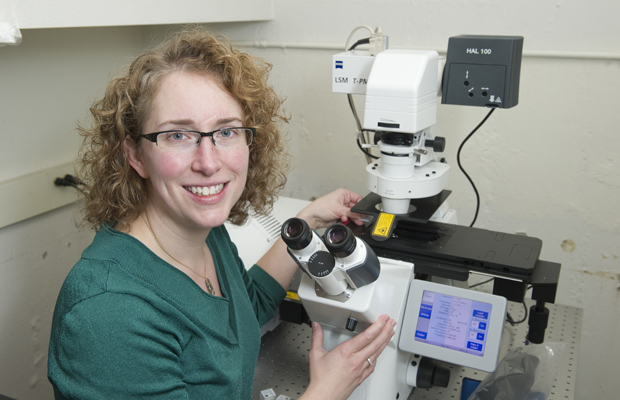The language of neural cells

Imagine if we could understand the language two neurons use to communicate. We might learn something about how thoughts and consciousness are formed. At the very least, our improved understanding of neuron communication would help biologists study the brain with more precision than ever before.
Heather Clark, an associate professor of pharmaceutical sciences at Northeastern University, has received a $300,000 Young Faculty Award from the Defense Advanced Research Projects Agency to explore neural cell communication using her expertise in nanosensors.
“We were interested in looking into neural cells because of the need to measure chemicals in the brain,” she explained.
In separate work, Clark had already been developing nanosensors to measure the biochemical environment inside a single neuron. The DARPA award will allow her team to extend the investigation to the biochemical reactions between cells. “We will use the chemistry developed for another DARPA project and apply it to making a sensor for neurotransmitter release,” Clark said.
The other DARPA project, she noted, enabled the team to incorporate enzymes into their sensor format. Postdoctoral researcher Kevin Cash did the bulk of this work, developing sensors that monitor the byproducts of enzymatic reactions.
As Clark put it, “We can measure a whole lot more molecules that way.”
When a neural cell sends a message to another cell, it releases molecules into the intercellular environment. The new nanosensor will incorporate an enzyme that reacts with these molecules to produce acidity changes. A pH monitor also incorporated into the nanosensor will recognize those acidity changes and produce a signal equivalent to the concentration of the neurotransmitter.
This indirect measurement process will allow Clark’s team to measure neurotransmitter levels without directly binding to them, a challenge in its own right. “But enzymes do a really great job of recognizing [these molecules] naturally,” said Clark. “It’s what they do best.”
The researchers have developed other sensors that use this same chemical protocol, but the difficulty lies in getting them into the intercellular space. “We’re not actually working in the whole brain, we’re working in slices [of the mouse brain],” Clark explained. “So we’re hoping to just flush it into the tissue layer.”
Collaborators at Harvard Medical School will apply their expertise in keeping brain tissue alive in solution for these types of tests. But before reaching that level of investigation, the Northeastern researchers will validate the nanosensors in in vitro and model cellular settings.
In addition to receiving funding, YFA awardees are paired with DARPA program managers who share similar interests. Clark’s mentor is a medical doctor with expertise in microscale and nanoscale biomedical technologies. “It’s always my goal to do something that is medically and clinically relevant,” Clark said. “I think that will be good insight.”
View selected publications of Heather Clark in IRis, Northeastern’s digital archive.





